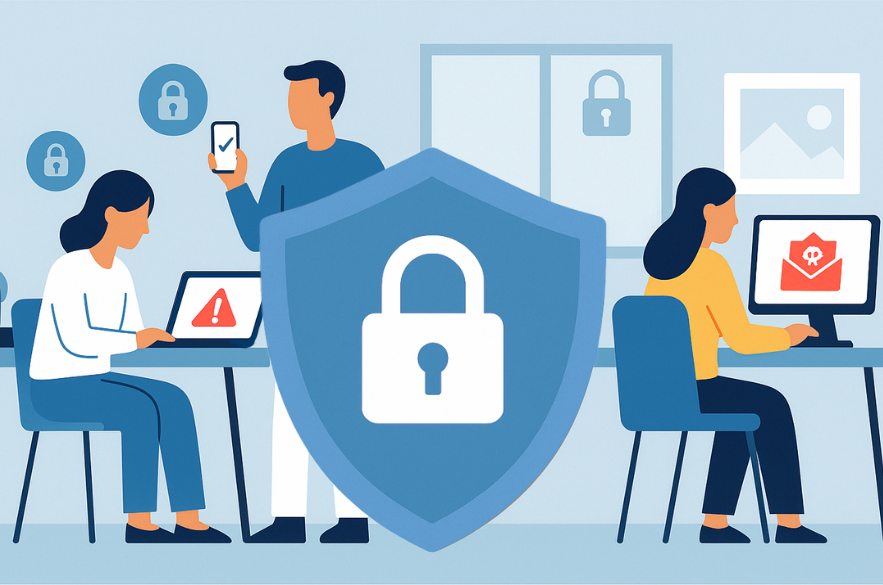Cybersecurity is no longer the sole domain of IT administrators. For small businesses, where staff often juggle multiple roles, security culture isn’t about having bigger budgets, it’s about smarter behaviour. A resilient cybersecurity culture turns every employee into a firewall.
According to the UK Government’s Cyber Security Breaches Survey 2025, 82% of small businesses experienced a phishing or social engineering attempt, yet only 29% had conducted a staff-wide awareness training in the past 12 months.
This disconnect between risk and response highlights a key insight: technical controls without cultural reinforcement are destined to fail.
What Is a Cybersecurity Culture, Really?
Cybersecurity culture refers to the collective mindset, behaviours, and routines of your team that determine how securely your organisation operates on a day-to-day basis. It’s not just policy, it’s practice.
In smaller teams, this manifests in:
- Shared responsibility for securing data
- Proactive threat reporting (not fear of punishment)
- Basic security embedded in daily workflows
- Clear understanding of risks tied to role-specific tasks
The European Union Agency for Cybersecurity (ENISA) defines it as the “attitudes, knowledge, assumptions, norms, and values of workforce members regarding cybersecurity”, making it a people issue as much as a technical one.
Why It’s More Critical for Small Teams Than Corporates
Larger enterprises often absorb breaches with layered defences and budget-heavy incident response. SMBs, on the other hand, are more vulnerable due to:
- Limited internal IT capacity
- High exposure through SaaS and remote tools
- Less formalised training and onboarding
- Lower awareness of regulatory consequences (GDPR, NIS2, CRA)
A report by Eurostat (2024) revealed that over 50% of data breaches in businesses with fewer than 50 employees were due to avoidable human error, not sophisticated hacking source: Eurostat
What a Strong Security Culture Looks Like in Practice
1. Security Onboarding as Standard
Every new hire, regardless of role, receives a security briefing tailored to their tools and data access. It includes:
- Recognising social engineering
- Using password managers
- Understanding personal liability under GDPR
2. Secure-by-Default Tools
Using tools that encourage security best practices without friction: 2FA by default, role-based access, encrypted messaging (e.g. Signal or MS Teams with compliance layers).
3. “Psychological Safety” for Reporting
Employees aren’t afraid to report mistakes, whether clicking a suspicious link or misconfiguring access. Incident response starts with open communication, not blame.
4. Visual Reminders, Not Just Policies
Posters near workstations, pop-up tips in tools, and microlearning modules help maintain awareness. Behavioural reinforcement beats once-a-year training.

Common Mistakes That Undermine Culture
Even well-meaning SMBs sabotage their own efforts by:
- Relying only on technical tools, thinking firewalls or anti-malware are “set-and-forget”
- Not tailoring policies; e.g. giving warehouse staff the same training as finance teams
- Treating security as compliance-only, focusing on ticking GDPR boxes vs. true readiness
- Ignoring third-party risks, e.g. letting vendors or freelancers bypass processes
According to the European Union Agency for Cybersecurity’s Threat Landscape Report 2025, third-party vendors were linked to 17% of cyber incidents reported by SMEs, up from 11% in 2023.

Case Example: A Small Legal Firm Adopts Cyber Culture
In early 2025, a 12-person legal firm in Bristol faced an internal scare: a paralegal accidentally opened a malware-laced attachment disguised as a case file. No controls were bypassed, but the incident triggered a full review.
Actions taken:
- Rolled out role-specific onboarding
- Migrated to a secure document exchange platform
- Began monthly phishing simulations
Outcome:
Within 3 months, phishing susceptibility dropped by 73% and a Cyber Essentials Plus certification was obtained, improving client trust and contract eligibility.

Cybersecurity Culture Is a Competitive Advantage
Small teams that embrace a security-first culture reduce breach risk, build customer trust, and even gain new business through compliance-readiness.
And it’s not about fear. It’s about empowerment.
SMBs that thrive in 2025 will be those where cybersecurity isn’t just a policy, it’s a shared, lived practice.
Ready to See Where You Stand?
At I‑NET Software Solutions, we partner with small business leaders to embed cybersecurity culture across teams, so every employee becomes a security-strength, not a weak link. Want to assess your team’s readiness and close the culture gap?
Book a Cybersecurity Culture Assessment with our experts today.
Recommended Read:
If you found this article useful, check out our previous post on the evolving threat landscape: “Phishing 3.0: Advanced Email Scams Hitting UK Small Businesses in 2025”, it examines how modern multi‑vector attacks exploit cultural weaknesses in organisations just like yours.
